Summer Blackberry Care Guide for a Great Harvest
Housewives prepare cakes, jams, preserves, jellies, smoothies and pies from ripe garden blackberries. Delicious and beautiful berries look appetizing on the festive table, they are rich in vitamins and microelements. Every year, more and more gardeners are planting berries on their land - these are summer residents not only from the southern, but also from the northern regions of the country. In the article, we will consider in detail how to care for blackberries in the summer so that there is a good harvest, and what nuances of care to observe.
The content of the article
Features of summer blackberry care
Summer care of berry bushes is a guarantee of a tasty and rich harvest. Blackberries need regular watering and fertilization, they love loose and weed-free soil.
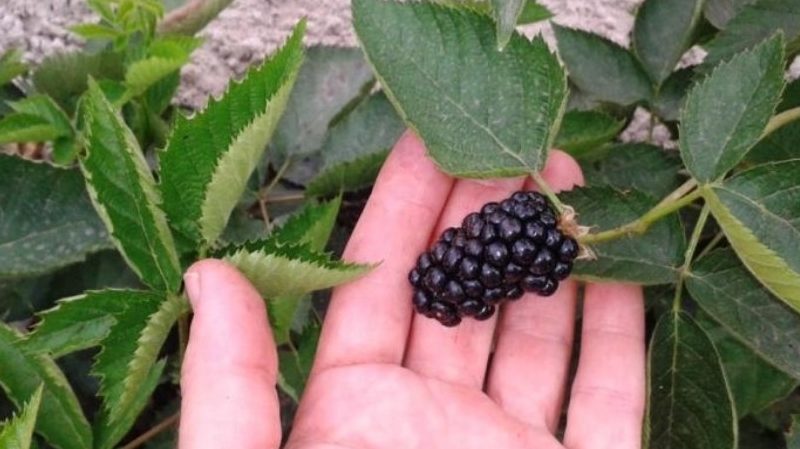
Basic rules of care:
- alternate root and foliar feeding;
- when watering, pay attention to weather conditions;
- annually carry out sanitary and formative pruning;
- loosen the ground once a week;
- carry out preventive treatments against diseases and pests.
What conditions are necessary for blackberries in summer
Blackberry shrubs love warmth, so gardeners plant them in areas that are warm and sheltered from the wind. The land should be light and nutritious, well lit by the sun's rays. The plant prefers fertile soil, a mixture of sandy loam and loamy soils.
The recommended humidity is about 85%, the berries ripen well at a temperature of + 24 ° C. The plant does not differ in frost resistance, therefore, at the end of the season, summer residents take additional care measures - they cut it off and cover for the winter.
How to care for blackberries in the summer for a good harvest
The culture is unpretentious in the care, however, if simple agrotechnical rules are not followed, it will not please with a good harvest.
Watering
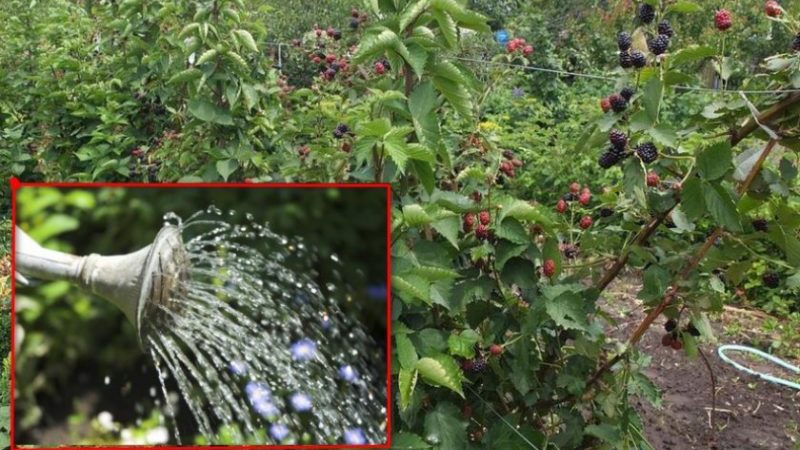
Blackberries require regular moisture. The roots of the shrub are located deep underground, so before the procedure, gardeners loosen the soil to a depth of 10 cm. This helps the water to penetrate deeper into the ground, staying in it longer.
It is recommended to use a liquid preheated in the sun. Watering with cold water from a spring or well provokes the spread of dangerous fungi and infections, which makes the shrub sick.
Water the blackberry as the soil dries. Lack of water is just as dangerous for the plant as too much water. The bush especially needs moisture during flowering and ripening of berries. The procedure is carried out in the morning or in the evening. It is also recommended to remove all weeds first - they take up some of the moisture.
When watering, pay attention to weather conditions. If the summer is dry and hot, up to 10 liters of water are consumed per bush; if it rains often - up to 6 liters.
Pruning
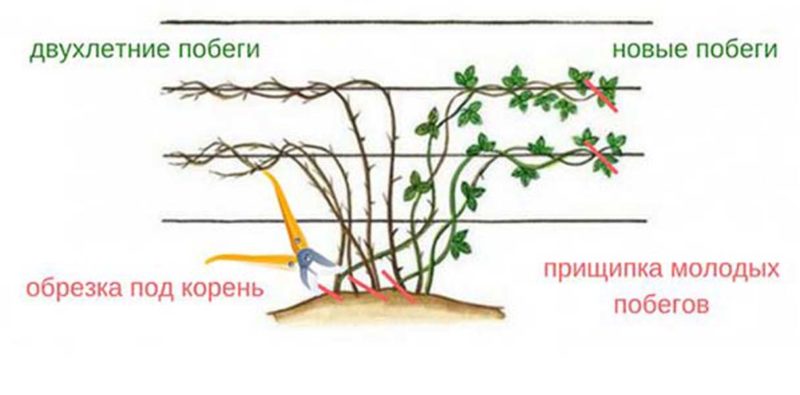
Prune blackberries annually, starting in the first year after planting. First of all, dry and diseased shoots are removed - they are shortened to the base. Be sure to remove frozen, broken and weak branches, the crop will still not form on them. At the end, shoots that are too long and those that grow in a chaotic manner are removed.
Experienced gardeners recommend leaving 4-6 fruiting branches on one shrub. The tops are cut off so that the bush is compact and well-groomed.
When carrying out the procedure, gardeners follow the recommendations:
- in the first year, the top and side shoots are removed, leaving a height of about 30 cm from the ground;
- in the second year, in the spring, they carry out sanitary pruning, and in the summer they pinch the buds of the lateral shoots;
- in the third year, the tops of the lateral shoots are shortened by 40 cm;
- in the fourth year, young branches are separated from fruiting ones, fan or wave pruning is chosen.
Inexperienced summer residents are afraid to cut off shoots, thinking that this will only harm the yield and shrubs. But this is not so: it is better to remove old branches in a timely manner, without waiting for them to dry out themselves.
The next year, new fruiting shoots will grow in their place, thereby increasing the yield. Pruning also reduces the likelihood of disease and insect pests.
Read also:
Top dressing
Blackberries love root and foliar fertilizers. They saturate the soil and shrubs with nutrients that strengthen the plant's immunity and increase yields.
When feeding, the number of elements introduced is observed. An overabundance or deficiency leads to the fact that the shrub is weakened, the berries grow small and tasteless.
In June, the plant is fertilized with organic fertilizers containing nitrogen. They stimulate the development of berries, strengthen the root system.
Summer residents use an infusion of bird droppings. For cooking, take 10 liters of water and 1 kg of rotted droppings, insist for a week in a warm place. After diluting 1 liter of infusion with 5 liters of pure water and watering the shrub at the root. Fertilizer should not get on shoots, leaves and fruits. Instead of infusion, you can use dry fertilizer - compost. 1 kg is laid under each bush.
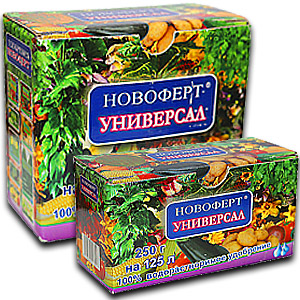
2-3 weeks before fruiting, the plant is sprayed with mineral fertilizers. These are products that contain a complex of essential trace elements: phosphorus, potassium, magnesium, iron, zinc, boron.
Summer residents use "Novofert", "Aminozol", "MicroMix". Fertilizer is diluted in water in accordance with the instructions. Complex compositions make the berries larger and juicier, improve their marketability.
Protection against diseases and pests
Blackberry diseases are classified into fungal, viral, and infectious. Rust, powdery mildew, purple spot, gray rot are often found on the bushes.
To prevent the appearance of diseases, the bush is sprayed with a solution of Bordeaux liquid (10 g of substance is required per 1 liter).
In case of symptoms of diseases (dry leaves and shoots, spots, deformation of fruits), professional methods of treatment are used - the drugs "TiovitJet" or "Topaz"... They combine the properties of a fungicide and microfertilizer, and have a quick contact action.
Of the pests, the bear, blackberry aphid, and weevil are noted. Insects appear due to weeds, infested soil, thickening of plantings. As a preventive measure, the shrubs are sprayed with soapy water (300 g of grated laundry soap is required for 10 liters of water).
In medicinal preparations, "Batrider" or "Gerold" are used. They are distinguished by high speed of impact and efficiency. Processing is carried out in dry and calm weather no earlier than 3 weeks before harvest.
Loosening
Loosening makes the soil more airy and lighter. If the soil is not loosened, a soil crust forms, which prevents oxygen from reaching the root system. Because of this, diseases develop and insect pests appear.
They loosen the soil throughout the summer using a garden hoe or hoe. The depth of loosening is 5-7 cm, the procedure is carried out after watering and rains. It is not recommended to loosen the blackberry under the leaves, it is better to retreat from the shrub 15 cm. Loosening is especially required in hot summer, when the soil is dry.
Mulching
Mulching is required to retain moisture. Under a layer of mulch, the soil remains moist, which prevents the roots from drying out. Hay, grass, sawdust are used as mulch.Mulching also fights soil erosion and prevents pests.
Mulch also performs a decorative function - the near-stem circle looks well-groomed and neat, weeds germinate less.
How to mulch the soil correctly:
- Choose a dry and windless day.
- Loosen, dig up the soil and remove weeds.
- Lay the mulch in an even layer without tamping.
When mulching blackberries in summer, it is recommended to use only green, dry materials, for example, mowed grass from the lawn.
Reproduction
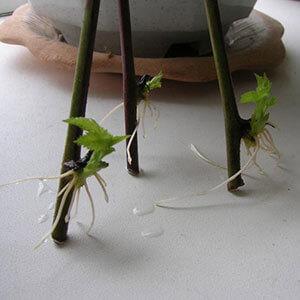
Blackberries are propagated by seeds, layering or cuttings. The last method is the most popular and simplest. In late autumn or early spring, they dig out the entire root system of the bush and divide it into parts. For planting, use young cuttings no more than 3 years old. Store them in a plastic bag, in a dark and dry place.
The thickness of the cutting should be about 1 cm, length 15 cm. The planting material is examined for the presence of diseases and pests. The cuttings should be free of stains, rot and other symptoms of infection.
Next, the stalk is disinfected with a solution of potassium permanganate, dipped in a clay mash and placed in a planting pit. The cuttings are placed in the holes in rows to a depth of 10-12 cm.
Preparing for winter
After pruning in August, the blackberries are prepared for winter. The shoots are treated with a solution of copper sulfate, with a decrease in temperature, they are tied and bent to the ground.
The plantings are insulated with wooden boards, hay and mulch - all this will help the blackberry not to freeze. Covering material is laid on top - dense polyethylene or agrofiber.
Gardeners recommend using wide canvases "Agrospana" or "Lutrasila". Non-woven synthetic materials allow air and moisture to pass through and at the same time protect the blackberry from freezing and damping. Shelter is especially required in cold regions of the country.
The nuances of summer care, depending on the type / variety of blackberries
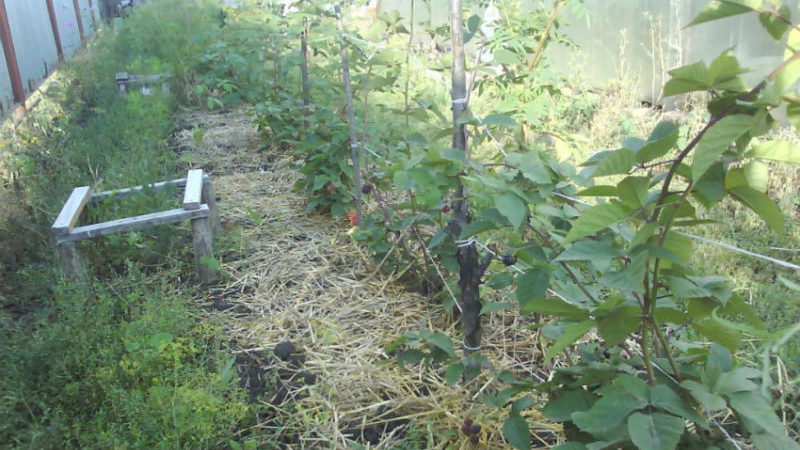
In the gardens they grow bushy, climbing, thornless blackberries. The bush is similar in appearance to raspberries; when caring for it, it is important to pay attention to pruning and shaping. Every year, gardeners carry out formative and sanitary pruning so that more large and juicy berries grow on the shoots.
Shrub blackberries bear fruit on two-year-old shoots, plant height reaches 2.5 m. Delicious varieties of bush blackberries - Ruben, Apache, Gazda.
Climbing blackberries are called "dew". She has long shoots that spread along the ground. Climbing blackberry stems are formed, and the remaining ends are pinched annually. Also, gardeners regularly examine the shoots to notice insects that easily hide inside the shrub.
Once every 2 weeks, climbing blackberries are treated with Tanrek. It protects the plant from aphids and whiteflies and has a long-lasting effect. The frost resistance of the dewweed is low, for the winter the plant requires a mandatory shelter. Popular Climbing Blackberries - Abundant, Oregon, Texas.
Depending on the region of cultivation
When grown in the northern regions, summer residents pay attention to complex mineral fertilizing, which are necessary to strengthen immunity. Thanks to them, shrubs are less likely to get sick. Over the summer, the plant is fertilized 2-3 times - before and after fruiting. Double superphosphate, urea, potassium salt are used. The complex is introduced in dry or liquid form under the bush, then sprinkled with earth.
If blackberries grow in regions with high humidity, the soil is loosened and mulched once every 3-4 days. This keeps the soil light and nutritious, and protects against pathogens and insect pests. The number of irrigations in such regions is being reduced.
Read also:
Raspberry varieties for the middle lane
Instructions for caring for raspberries in spring after winter and advice from experienced gardeners
Useful Tips
The berries ripen in July or August, depending on the ripening period.
To make the harvest tasty, gardeners recommend:
- in the second year after planting, tie the blackberry to the trellis;
- pick berries immediately after ripening;
- choose slightly acidic or neutral soil for planting;
- make a layer of mulch no thicker than 5 cm;
- do not plant blackberries next to raspberries;
- for spraying and dressing, use folk remedies - nettle infusion or eggshells;
- pruning with a sharp pruner.
Conclusion
Caring for blackberries in summer is simple; most importantly, follow the basic recommendations. The berry does not like waterlogging, therefore, when watering, pay attention to the condition of the soil. If it is still wet, the procedure is postponed to another day.
Fertilize blackberries with organic matter and minerals, alternate root and foliar methods. Urea, superphosphate, potassium salt are used. Every year, the shrub is pruned and shaped, and preventive procedures are regularly carried out to protect against diseases and pests.